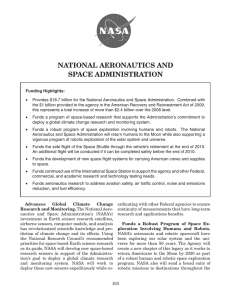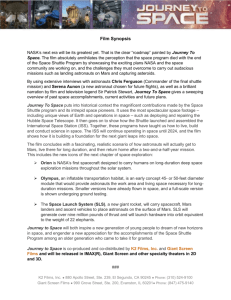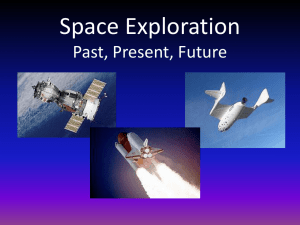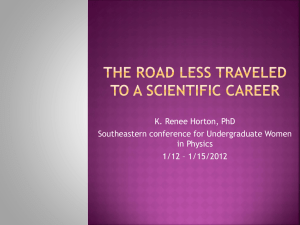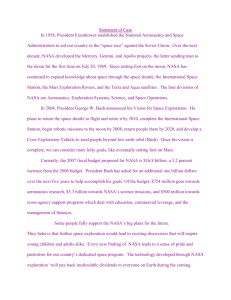Committee on Science U.S. House of Representatives Hearing Charter
advertisement
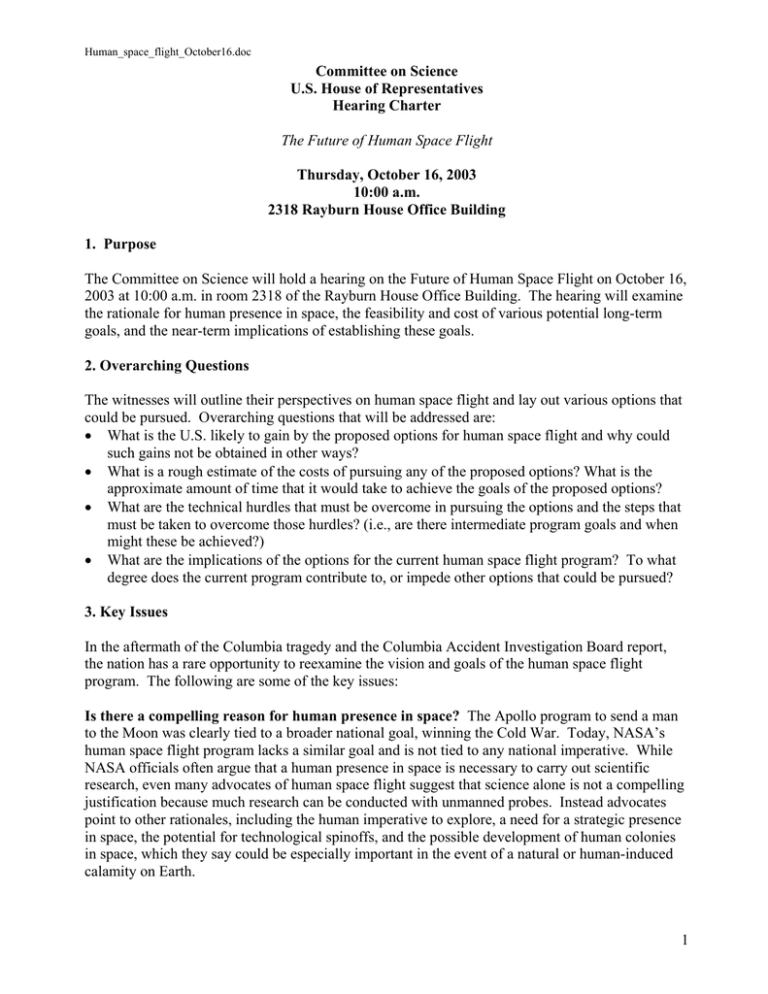
Human_space_flight_October16.doc Committee on Science U.S. House of Representatives Hearing Charter The Future of Human Space Flight Thursday, October 16, 2003 10:00 a.m. 2318 Rayburn House Office Building 1. Purpose The Committee on Science will hold a hearing on the Future of Human Space Flight on October 16, 2003 at 10:00 a.m. in room 2318 of the Rayburn House Office Building. The hearing will examine the rationale for human presence in space, the feasibility and cost of various potential long-term goals, and the near-term implications of establishing these goals. 2. Overarching Questions The witnesses will outline their perspectives on human space flight and lay out various options that could be pursued. Overarching questions that will be addressed are: • What is the U.S. likely to gain by the proposed options for human space flight and why could such gains not be obtained in other ways? • What is a rough estimate of the costs of pursuing any of the proposed options? What is the approximate amount of time that it would take to achieve the goals of the proposed options? • What are the technical hurdles that must be overcome in pursuing the options and the steps that must be taken to overcome those hurdles? (i.e., are there intermediate program goals and when might these be achieved?) • What are the implications of the options for the current human space flight program? To what degree does the current program contribute to, or impede other options that could be pursued? 3. Key Issues In the aftermath of the Columbia tragedy and the Columbia Accident Investigation Board report, the nation has a rare opportunity to reexamine the vision and goals of the human space flight program. The following are some of the key issues: Is there a compelling reason for human presence in space? The Apollo program to send a man to the Moon was clearly tied to a broader national goal, winning the Cold War. Today, NASA’s human space flight program lacks a similar goal and is not tied to any national imperative. While NASA officials often argue that a human presence in space is necessary to carry out scientific research, even many advocates of human space flight suggest that science alone is not a compelling justification because much research can be conducted with unmanned probes. Instead advocates point to other rationales, including the human imperative to explore, a need for a strategic presence in space, the potential for technological spinoffs, and the possible development of human colonies in space, which they say could be especially important in the event of a natural or human-induced calamity on Earth. 1 Human_space_flight_October16.doc What are the appropriate roles for robotic exploration and human exploration? Robotic spacecraft have landed on the Moon and Mars, and (in the case of the Soviet Union) on Venus. Robotic spacecraft have flown by every planet in the Solar System with the exception of Pluto, and NASA is currently developing a mission to that planet. Robotic spacecraft provide a wealth of scientific information and typically cost a fraction of what a human mission costs. In January 2004, NASA’s Mars Exploration Rovers Mission will land two identical rovers, named Spirit and Opportunity, on the Martian surface to search for clues of water. This mission cost less than $1 billion. In some cases, robotic spacecraft and human missions work together to perform complementary tasks, such as when astronauts service and repair the Hubble Space Telescope or when robotic missions are used to scout out landing sites for human missions as was done before Apollo. Key issues include: What is the appropriate balance between robotic and human missions? What activities can only be accomplished with humans? Should NASA focus its efforts on robotic exploration until a suitable purpose can be developed and agreed upon for human exploration? How would the Space Shuttle, the International Space Station and other aspects of the current human space flight program fit with any vision for NASA’s future? Neither the Space Shuttle nor the Space Station has met its primary original goal. The Shuttle, for example, has not led to low-cost, routine, and reliable access to space; the Space Station is no longer being designed to provide a space-based platform to assemble and launch missions beyond Earth’s orbit. Some advocates of a bolder mission for NASA argue that both the Shuttle and the Space Station consume large amounts of money simply to send humans repeatedly into Low Earth Orbit (LEO) without moving toward any more ambitious or compelling goal. Others point out that the Space Station could contribute to future missions by providing data on how the human body reacts to prolonged stays in space. It is not clear how the Orbital Space Plane – the next vehicle on the drawing boards at NASA – would contribute to future missions. While NASA has talked about having the Space Plane contribute to longer-range goals, it is being designed only to ferry astronauts back and forth to the Space Station. What technological barriers must be overcome? Human space flight is inherently dangerous. Human space exploration beyond Earth orbit is particularly hazardous because the radiation environment beyond the protective Van Allen belts1 is much greater than the radiation levels experienced on the Space Station. Furthermore, the increased distance from Earth makes it impractical, and in some cases impossible, to return quickly if a problem arises. Also, it has been clearly demonstrated that near-zero gravity has a slowly debilitating effect on human physiology. For example, astronauts can lose between 6 and 24 percent of their bone mass over the course of a year in space.2 Depending on the duration and destination of the mission, improved technologies for propulsion, power, and life support systems may need to be developed. What can we afford? The U.S. spends more than $6 billion annually on human space flight, including the Space Shuttle, Space Station, and Space Station research. This amount accounts for more than 40 percent of NASA’s budget. Both Space Station and Space Shuttle have cost significantly more than originally expected and, following the Columbia tragedy, Shuttle costs are likely to increase. A large and sustained investment is likely to be necessary for any ambitious 1 The Van Allen Belts are layers of charged high-energy particles located above Earth's atmosphere (4000 to 40,000 miles up). The magnetic field of the belts protect the Earth and astronauts on Space Station from cosmic radiation. 2 http://spaceresearch.nasa.gov/general_info/issphysiology.html 2 Human_space_flight_October16.doc human space flight mission to succeed. NASA spending accounted for as much as 3.5 percent of the entire federal budget during the Apollo program, but today represents less than 1 percent of federal spending. Is the U.S. prepared to make NASA a sustained funding priority? 4. Background - Previous Studies on Future Goals for Space3 Over the last 40 years, numerous studies, commissions, and task forces have attempted to address the future of the U.S. civil space program, and the human space flight program in particular. The following provides a summary of several key studies. National Commission on Space – (The Paine Commission, 1986) In 1984, Congress created a commission to look at the long-term future of the civil space program. Chaired by former NASA Administrator Thomas O. Paine, the 15-member panel spent a year developing a 50-year plan. This plan was detailed in their report Pioneering the Space Frontier. In summary, the Commission called for the United States to lead the way in opening the inner solar system for science, exploration, and development. The Commission envisioned the establishment of bases on the Moon and Mars and the creation of a routine transportation system among the Earth, Moon, and Mars. The Commission emphasized that it was not trying to predict the future, but rather show what the United States could do if it chose to do so. The Commission envisioned human exploration missions returning to the Moon by 2005 and going to Mars by 2015. The report detailed a program involving both robotic and human exploration, acting synergistically to achieve the goal of opening the solar system. The report did not provide a cost estimate for carrying out its recommendations, but identified three principal benefits: (1) advancement of science and technology; (2) economic benefit of low-cost launch systems; and (3) opening up new worlds on the space frontier. Leadership and America’s Future in Space – (The Ride Report, 1987) Astronaut Sally Ride’s report Leadership and America’s Future in Space was prepared as an internal NASA report. The report stated that the U.S. had lost its leadership in space and was in danger of being surpassed by other countries. The report argued that to regain leadership the U.S. space program must have two attributes: (1) a sound program of scientific research and technology development; and (2) significant and visible accomplishments. The report detailed four programs areas for comparatively near-term (15-20 year) activities: Mission to Planet Earth (now called Earth Science), robotic exploration of the solar system, a Moon base, and sending humans to Mars. The report recommended that NASA pursue programs in each of these areas. The report envisioned humans returning to the Moon by 2000, preceded by robotic probes to select a site for the Moon base. The report proposed one-year expeditionary missions to Mars between 2005 and 2010. The report concluded that settling Mars should be an eventual goal. As a result of the Ride report, NASA established the Office of Exploration to investigate long-range proposals for human exploration to the Moon and Mars. President Bush’s Space Exploration Initiative (SEI) -- 1989-1993 On July 20, 1989, the 20th anniversary of the first Apollo landing on the Moon, President Bush made a major space policy address, endorsing the goal of returning humans to the Moon and then going on to Mars “in the 21st Century.” The program was referred to as the Space Exploration Initiative (SEI). At the time the President made his statement in 1989, the Director of the Office of 3 Based on Congressional Research Service Report 95-873, Space Activities of the United States, CIS [the Commonwealth of Independent States] and other Launching Countries/Organizations 1957-1994, Marcia S. Smith, Specialist in Science and Technology Policy 3 Human_space_flight_October16.doc Management and Budget suggested that the program would cost $400 billion over 30 years. While Congress endorsed the philosophy of the program, Congress was reluctant to approve the program because of the expected cost. The SEI program was formally terminated in 1993 and the NASA Office of Exploration was dismantled. The Advisory Committee on the Future of the U.S. Space Program – (The Augustine Report, 1990) In 1990, concerns about problems with several NASA programs (Hubble Space Telescope’s flawed mirror, hydrogen leaks grounding the Shuttle for five months, and several issues with the Space Station program) prompted the White House to strongly encourage NASA to establish an outside advisory panel to reviews its programs and management. The panel was chaired by then-Chairman and CEO of Martin Marietta Inc., Norman Augustine. The panel recommended that NASA’s budget increase by 10 percent per year after inflation. The report recommended activities for NASA in five major areas. They were: (1) Space Science (e.g., Hubble Space Telescope), which the report said should be NASA’s highest priority and be maintained at 20 percent of NASA’s overall budget; (2) Mission to Planet Earth (now called Earth Science); (3) Mission from Planet Earth, which would include robotic spacecraft needed as precursors to human exploration. The long-term goal would be human exploration of Mars. No specific timetable for this mission was set. Instead, the panel urged NASA to adopt a philosophy of “go-as-you-pay;” (4) space technology, (i.e., design of subsystems and materials for spacecraft) for which the report said spending should double or triple; and (5) development of a “heavy lift” unmanned, expendable launch vehicle to complement the Space Shuttle. The panel stated that if the 10 percent budget increases were not available the programs should be prioritized as follows: (1) Space Science; (2) Mission to Planet Earth; (3) heavy lift launch vehicle; (4) technology development: and (5) Mission from Planet Earth. National Academy of Sciences Study – The Human Exploration of Space, 1997 In 1997, the Academy undertook a study of the role of science in human space exploration. The study examined scientific activities that must be conducted before human exploration beyond Earth orbit could be practically undertaken and science that would be enabled or facilitated by human presence. The study concluded that clear goals must be set and that an integrated science program, with the appropriate balance of human and robotic missions, to collect relevant data to enable future missions beyond Earth orbit should be pursued. Columbia Accident Investigation Board (CAIB) – (The Gehman Report, 2003) In its August report, the CAIB concluded that there was a problematic mismatch between NASA’s missions and its budget. This occurred because NASA and/or Congress failed to scale back NASA’s missions when funding did not match requested levels or when initial cost estimates proved to be inaccurate. The CAIB also pointed out that “for the past three decades, NASA has suffered because of the “lack…of any national mandate providing NASA a compelling mission requiring human presence in space.” The CAIB stated that investments in a “next generation launch vehicle” will be successful only if the investment “is sustained over the decade; if by the time a decision to develop a new vehicle is made there is a clearer idea of how the new space transportation system fits into the nation’s overall plans for space; and if the U.S Government is willing at the time a development decision is made to commit the substantial resources required to implement it.” For further CAIB comments, see Attachment A. 4 Human_space_flight_October16.doc 5. Witnesses Dr. Michael Griffin is the President and Chief Operating Officer of In-Q-Tel. He has nearly 30 years of experience managing information and space technology organizations. Dr. Griffin has served as Executive Vice President and CEO of Magellan Systems Division of Orbital Sciences Corporation, and as EVP and General Manager of Orbital Space Systems Group. Prior to that he served as both the Chief Engineer and Associate Administrator for Exploration at NASA, and at the Pentagon as the Deputy for Technology of the Strategic Defense Initiative Organization. Dr. Wesley T. Huntress is the Director of the Carnegie Institution's Geophysical Laboratory. From 1993 to 1998 he was NASA’s Associate Administrator for Space Science. In this position he was responsible for NASA's programs in Astrophysics, Plane tary Exploration and Space Physics. Previously, he was Director of the Solar System Exploration Division. Dr. Huntress earned his B.S. in Chemistry at Brown University in 1964, and his Ph.D. in Chemical Physics at Stanford University in 1968. He is the recipient of a number of honors including the NASA Exceptional Service Medal. Dr. Matthew B. Koss is an Assistant Professor of Physics of the College of Holy Cross in Worcester, Massachusetts. He has been the Lead Scientist on several Space Shuttle microgravity flight experiments flown on STS-62, STS-75, and STS-87. He received an AB degree from Vassar College in 1983 and a Ph.D. in Experimental Condensed Physics from Tufts University in 1989. Dr. Alex Roland is Professor of History and Chairman of the Department of History at Duke University, where he teaches military history and the history of technology. From 1973 to 1981 he was a historian with NASA. He has written and lectured widely on the United States manned space flight program. He is past President of the Society for the History of Technology and of the U.S. National Committee of the International Union for the History and Philosophy of Science. Dr. Bruce Murray is Professor Emeritus of Planetary Science and Geology at the California Institute of Technology. He was Director of the NASA/Caltech Jet Propulsion Laboratory from 1976 to 1982, which included the Viking landings on Mars and the Voyager mission through Jupiter and Saturn encounters. In 1979, he, the late Carl Sagan, and Louis Friedman founded The Planetary Society. He has published over 130 scientific papers and authored or co-authored six books. He received his college education at M.I.T., culminating in the Ph.D. in 1955. 6. Witness Questions All the witnesses except Dr. Koss were asked to layout an option that they believed NASA should pursue and answer the following questions in their testimony: • What is the U.S. likely to gain by your proposed option for human space flight and why could such gains not be obtained in other ways? • What is a rough estimate of the costs of pursuing your proposed option? What is the approximate amount of time that it would take to achieve the goals of your proposed option? • What are the technical hurdles that must be overcome in pursuing your option and the steps that must be taken to overcome those hurdles? (i.e., are there intermediate program goals and when might these be achieved?) • What are the implications of your option for the current human space flight program? To what degree does the current program contribute to, or impede other options that could be pursued? 5 Human_space_flight_October16.doc Dr. Koss was asked to answer these questions: • How necessary is it to have the participation of people in space for successful research in material sciences? What proportion, if any, of the experiments now conducted on the Space Shuttle or Space Station could be conducted autonomously with unmanned systems? If researchers no longer had access to the Space Shuttle or Space Station how would advancement in the material sciences be affected? • What alternatives exist to carry to orbit micro-gravity experiments that could be conducted autonomously if the Space Shuttle or Space Station were not available for whatever reason? If none, how much would it cost NASA to provide researchers such an alternative? • To what extent, if any, would a more ambitious mission for NASA, such as sending people back to the moon or to Mars, be likely to provide material science researchers with unique opportunities for experimentation? 7. Attachments: • Attachment A: Excerpt from the Columbia Accident Investigation Board Report. • Attachment B: NASA’s five-year budget runnout. • Attachment C: Editorial by Dr. Matthew B. Koss 6 Human_space_flight_October16.doc ATTACHMENT A Excerpted from the Columbia Accident Investigation Board Report Volume 1, Chapter 9, August 2003. “Lack of a National Vision for Space In 1969 President Richard Nixon rejected NASA's sweeping vision for a post-Apollo effort that involved full development of low-Earth orbit, permanent outposts on the moon, and initial journeys to Mars. Since that rejection, these objectives have reappeared as central elements in many proposals setting forth a long-term vision for the U.S. Space program. In 1986 the National Commission on Space proposed “a pioneering mission for 21st-century America: To lead the exploration and development of the space frontier, advancing science, technology, and enterprise, and building institutions and systems that make accessible vast new resources and support human settlements beyond Earth orbit, from the highlands of the Moon to the plains of Mars.”4 In 1989, on the 20th anniversary of the first lunar landing, President George H.W. Bush proposed a Space Exploration Initiative, calling for “a sustained program of manned exploration of the solar system.”5 Space advocates have been consistent in their call for sending humans beyond low-Earth orbit as the appropriate objective of U.S. space activities. Review committees as diverse as the 1990 Advisory Committee on the Future of the U.S. Space Program, chaired by Norman Augustine, and the 2001 International Space Station Management and Cost Evaluation Task Force have suggested that the primary justification for a space station is to conduct the research required to plan missions to Mars and/or other distant destinations. However, human travel to destinations beyond Earth orbit has not been adopted as a national objective. The report of the Augustine Committee commented, “It seems that most Americans do support a viable space program for the nation – but no two individuals seem able to agree upon what that space program should be.”6 The Board observes that none of the competing long-term visions for space have found support from the nation's leadership, or indeed among the general public. The U.S. civilian space effort has moved forward for more than 30 years without a guiding vision, and none seems imminent. In the past, this absence of a strategic vision in itself has reflected a policy decision, since there have been many opportunities for national leaders to agree on ambitious goals for space, and none have done so.” 4 National Commission on Space Pioneering the Space Frontier: An Exciting Vision of our Next Fifty Years in Space, Report of the National Commission on Space (Bantam Books, 1986), p. 2. 5 President George H. W. Bush, “Remarks on the 20th Anniversary of the Apollo 11 Moon Landing,” Washington, D.C., July 20, 1989. 6 “Report of the Advisory Committee on the Future of the U.S. Space Program,” December 1990, p. 2. 7 Human_space_flight_October16.doc ATTACHMENT B NASA FY 2004 Budget (Budget Authority - $ millions) Business as Usual By Appropriation Account By Enterprise By Theme Science, Aero, & Exploration FULL COST Est. Pres. Req. FY03 Pres. Req. FY03 FY04 FY05 FY06 FY07 FY08 7,015 7,101 7,661 8,269 8,746 9,201 9,527 Space Science Solar System Exploration Mars Exploration Astronomical Search for Origins Structure &Evolution of the Univ. Sun-Earth Connections Institutional 3,414 976 496 698 331 544 370 3,468 1,046 551 799 398 674 -- 4,007 1,359 570 877 432 770 -- 4,601 1,648 607 968 418 959 -- 4,952 1,843 550 1,020 428 1,111 -- 5,279 1,952 662 1,022 475 1,169 -- 5,573 2,054 685 1,061 557 1,216 -- Earth Science Earth System Science Earth Science Applications Institutional 1,628 1,249 62 318 1,610 1,529 81 -- 1,552 1,477 75 -- 1,525 1,440 85 -- 1,598 1,511 87 -- 1,700 1,606 94 -- 1,725 1,629 96 -- Biological & Physical Research Biological Sciences Research Physical Sciences Research Commercial Research & Support Institutional + AM + SAGE 842 245 247 170 181 913 304 351 254 3 973 359 353 261 -- 1,042 399 392 251 -- 1,087 453 380 254 -- 1,118 456 409 253 -- 1,143 481 401 262 -- Aeronautics Aeronautics Technology Institutional 986 541 445 949 949 -- 959 959 -- 932 932 -- 939 939 -- 934 934 -- 916 916 -- Education Programs Education 144 144 160 160 170 170 169 169 169 169 170 170 170 170 7,960 7,875 7,782 7,746 7,881 8,066 8,247 Space Flight Space Station Space Shuttle Space Flight Support Institutional 6,131 1,492 3,208 239 1,192 6,107 1,851 3,786 471 -- 6,110 1,707 3,968 432 -- 6,027 1,587 4,020 419 -- 6,053 1,586 4,065 402 -- 6,198 1,606 4,186 407 -- 6,401 1,603 4,369 429 -- Crosscutting Technology Space Launch Initiative Mission & Sci. Measurement Tec Innov. Tech Trans. Partnership Institutional 1,829 879 275 147 528 1,768 1,150 434 183 -- 1,673 1,065 438 169 -- 1,720 1,124 435 161 -- 1,828 1,221 439 168 -- 1,868 1,257 439 172 -- 1,846 1,224 444 179 -- 25 25 26 28 29 30 31 15,000 15,000 15,469 16,043 16,656 17,297 17,806 Space Flight Capabilities Inspector General TOTAL 8 Human_space_flight_October16.doc ATTACHMENT C Copyright 2003 The New York Times Company The New York Times June 29, 2003, Sunday, Late Edition - Final How Science Brought Down the Shuttle By Matthew B. Koss; Matthew B. Koss is an assistant professor of physics at the College of the Holy Cross. As a scientist whose experiments were carried out on three missions of the space shuttle Columbia, I have been following with great interest the findings of the board looking into the shuttle's demise. Though a piece of foam may be found ultimately responsible, as the Columbia Accident Investigation Board announced last week, on some level I feel personally culpable for the loss of the seven astronauts. In-orbit experiments like mine have been used to justify manned space projects like the shuttle for decades. The truth is that the vast majority of scientific experiments conducted in orbit -- including my own - do not require astronauts. The main reason for in-orbit experimentation is to observe how a scientific process works without gravity-driven influences. But almost all of these tests, save those that must be done on humans, can be controlled from the ground via computer or by robots in space. In fact, some of the best work is done this way when the crew is asleep, not moving about and causing vibrations. To be sure, a lot of important science has been conducted in orbit. For example, research on the large single crystals of silicon that are at the heart of computer chips arose from the many detailed studies of crystal growth on the space shuttle. But, in fact, experiments like these are often more efficient and yield more fruitful results when done without the involvement of astronauts. The science performed on the shuttle can be classified as either a payload or a mid-deck laboratory experiment. Payload experiments are self-contained packages mounted in the payload bay, the wide open space in the back of the shuttle. They either run autonomously or are controlled remotely via computers on the ground. Laboratory experiments are performed in the mid-deck or Spacelab module, and are done by the astronauts with computer assistance from the ground. My experiments, on the fundamentals of how liquids turn into solids, were originally planned for the mid-deck, where they would be controlled by an astronaut who was scheduled to do eight tests. But because of launching delays, the project was changed to a payload experiment that would perform tests autonomously. During the flight, initial data was transmitted to the ground and analyzed by me and my colleagues. Performing the experiment remotely, without crew involvement, allowed us to do 63 test runs. Remote-controlled experiments may seem to contradict images we have grown accustomed to -- of happy, busy astronauts manipulating scientific equipment or talking about the science on board, or occasionally reporting on the objectives of experiments. But this public image of astronauts as laboratory scientists working on their own experiments is a bit misleading. Since the Mercury 7 pioneers, the astronaut corps has served one overriding political and public relations purpose -- to sell the space program. 9 Human_space_flight_October16.doc The idea of using the space shuttle as a scientific laboratory actually came about after the shuttle's design was already in place. The shuttle program was conceived in the waning days of the Apollo program as the best option to continue a manned space program at the lowest cost. However, without a place to shuttle to, and not nearly enough satellites that needed a shuttle to launch or repair them, the shuttle program succeeded in doing little beyond creating a human presence in space. The idea of the shuttle as an in-orbit lab was used as a justification for investment in its future. Similarly, the International Space Station has been aggressively marketed as a science lab. In fact, the station is seriously flawed in that too much crew time needs to be committed to station maintenance, and too many of the planned experiments depend on crew operations when they could more effectively be done without them. In many cases, the crew is needed only to deploy an autonomous experiment. Because of cost overruns and budget problems, the station's crew was cut back to three from the planned seven. Originally, 120 astronaut-hours per week were to have been devoted to science; this has been cut back to 20 hours per week. With the shuttle program grounded once again, it has become even more difficult to exchange crews, replace experiments or repair and refurbish equipment. Scientific experimentation in space can be safer and more cost effective using long-duration remote controlled orbital spacecraft. At the outset, the costs of developing this technology may appear greater than simply perfecting the shuttle. But if you do not need to provide a safe and sustaining environment for astronauts -- making sure takeoffs and landings aren't too fast, providing enough food and oxygen -- the overall cost will be significantly reduced. If NASA is not able to convince the public of the importance of science in orbit without astronaut involvement, then so be it. At least America's refusal to support science would be honest, would not needlessly endanger human lives or compromise the integrity of science and scientists. We will always need astronauts to assume certain risks to develop the technology that allows for human exploration of space. The space shuttles and space stations may be necessary to fulfill that mission. However, we need to separate the goal of scientific experimentation from the desire for space exploration. I hope that the unfortunate death of the Columbia astronauts will forever sever the false link that has been created between the two. Astronauts do not risk their lives to perform scientific experiments in space. They fly to fulfill a much more basic and human desire -- to experience the vastness of space. 10

